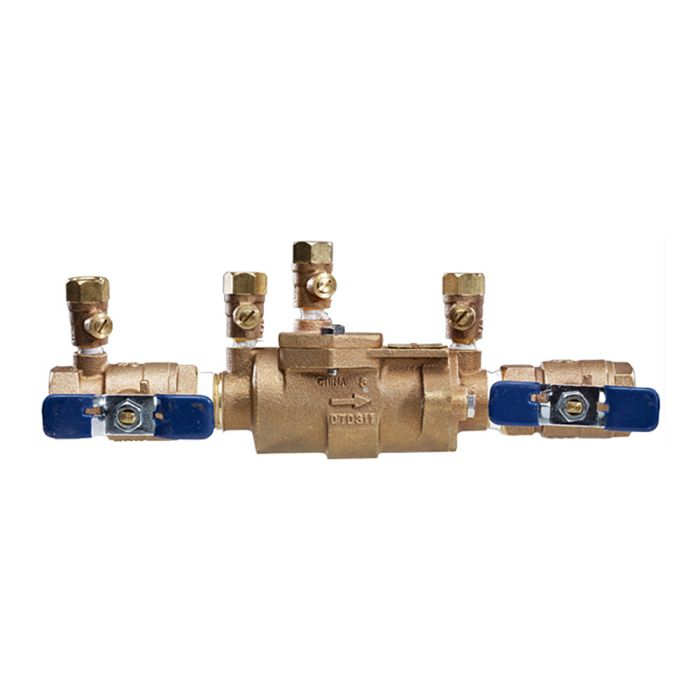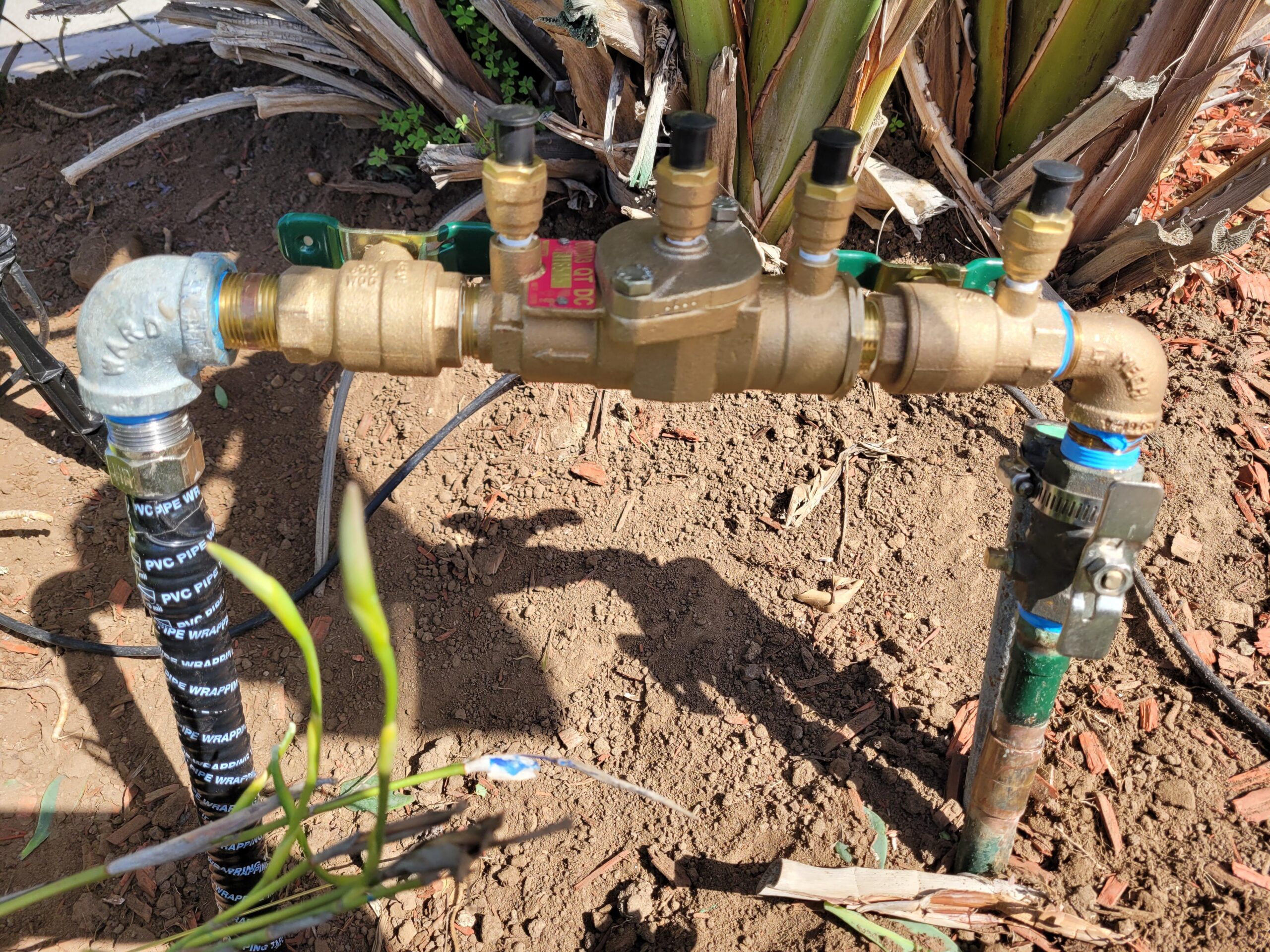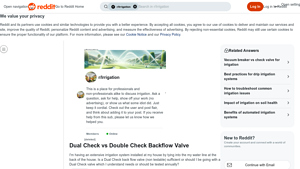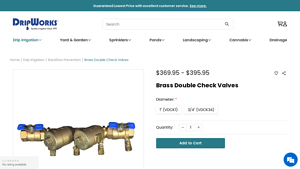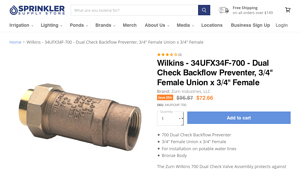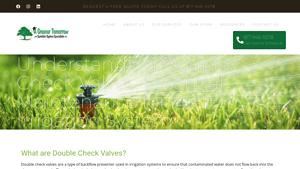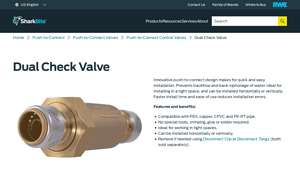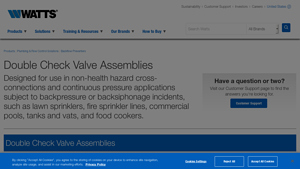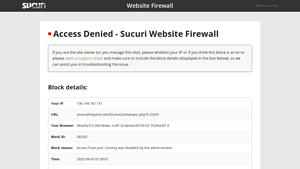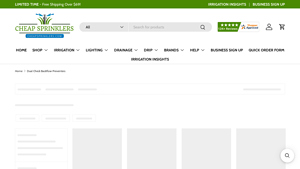Introduction: Navigating the Global Market for dual check valve irrigation
In today’s global market, sourcing dual check valve irrigation systems presents a unique challenge for B2B buyers, particularly those operating in regions such as Africa, South America, the Middle East, and Europe. The need for efficient irrigation solutions that prevent backflow and safeguard potable water supplies is critical, yet navigating through diverse supplier options, varying regulations, and distinct environmental conditions can be daunting. This guide aims to demystify the complexities of dual check valve irrigation by providing a comprehensive overview of the types, applications, and essential considerations for selecting these vital components.
From understanding the specific applications of dual check valves in various irrigation systems to evaluating supplier credentials and compliance with local regulations, this guide equips international buyers with the knowledge necessary to make informed purchasing decisions. It will also delve into cost implications and maintenance practices to ensure long-term efficiency and reliability in irrigation setups.
By empowering B2B buyers with actionable insights, this resource fosters confidence in sourcing decisions, ultimately leading to enhanced operational efficiency and sustainability in diverse agricultural landscapes. Whether you are in Vietnam or Nigeria, navigating the intricacies of dual check valve irrigation has never been more accessible.
Understanding dual check valve irrigation Types and Variations
| Type Name | Key Distinguishing Features | Primary B2B Applications | Brief Pros & Cons for Buyers |
|---|---|---|---|
| Standard Brass Dual Check | Heavy-duty brass construction, lead-free options available | Residential and commercial irrigation systems | Pros: Durable, easy maintenance. Cons: Higher initial cost. |
| Plastic Dual Check Valve | Lightweight, corrosion-resistant material | Agricultural irrigation, landscape applications | Pros: Cost-effective, lightweight. Cons: Less durable than brass. |
| Reduced Pressure Zone (RPZ) | Includes a relief valve for high-risk applications | Systems with chemicals or fertilizers | Pros: High protection level. Cons: More expensive, requires maintenance. |
| Heavy-Duty Cast Iron Valve | Robust construction, suitable for high-pressure systems | Industrial irrigation systems | Pros: Extremely durable, high pressure capacity. Cons: Heavy, may require specialized installation. |
| Compact Dual Check Assembly | Space-saving design, easy to install | Urban landscaping, limited-space installations | Pros: Efficient use of space. Cons: Limited pressure ratings. |
What Are the Characteristics of Standard Brass Dual Check Valves?
Standard brass dual check valves are recognized for their heavy-duty construction and lead-free options, making them suitable for both residential and commercial irrigation systems. These valves create a reliable barrier against backflow, ensuring the safety of potable water supplies. When considering a purchase, B2B buyers should evaluate their system’s pressure requirements and compatibility with existing infrastructure, as well as the potential for long-term durability against environmental factors.
How Do Plastic Dual Check Valves Compare in Durability?
Plastic dual check valves offer a lightweight and corrosion-resistant alternative, ideal for agricultural and landscape irrigation applications. Their cost-effectiveness makes them attractive for businesses operating on tighter budgets. However, buyers should be aware that while they are generally easier to handle and install, they may not withstand extreme conditions as well as their brass counterparts. Evaluating the specific environmental conditions of the installation site is crucial for making an informed decision.
Why Choose Reduced Pressure Zone (RPZ) Assemblies?
Reduced Pressure Zone assemblies are designed for high-risk applications where backflow could introduce contaminants, such as systems utilizing chemicals or fertilizers. They include a relief valve to manage pressure, providing an additional layer of safety. While RPZs offer superior protection, they come at a higher cost and require regular maintenance. B2B buyers should weigh the necessity of this level of protection against their budget and regulatory requirements, especially in regions with stringent water safety regulations.
What Are the Advantages of Heavy-Duty Cast Iron Valves?
Heavy-duty cast iron valves are built to withstand high pressures and are ideal for industrial irrigation systems. Their robust construction ensures longevity and reliability in demanding environments. However, the weight of these valves can complicate installation and may necessitate specialized equipment. Buyers should consider the specific needs of their irrigation systems and the potential trade-offs between durability and installation complexity when evaluating these options.
How Do Compact Dual Check Assemblies Benefit Urban Landscapes?
Compact dual check assemblies are designed for limited-space installations, making them particularly useful in urban landscaping projects. Their space-saving design allows for efficient use of small areas while maintaining functionality. However, these assemblies may have limited pressure ratings, which could restrict their application in larger systems. B2B buyers should assess the pressure requirements and spatial constraints of their projects to determine if compact assemblies are the right fit.
Key Industrial Applications of dual check valve irrigation
| Industry/Sector | Specific Application of dual check valve irrigation | Value/Benefit for the Business | Key Sourcing Considerations for this Application |
|---|---|---|---|
| Agriculture | Irrigation systems for crop production | Protects potable water supply, ensuring crop safety | Compliance with local regulations, pressure ratings, and material durability |
| Landscaping | Residential and commercial landscape irrigation systems | Maintains water quality while minimizing contamination risks | Size compatibility with existing systems and ease of maintenance |
| Golf Courses | Backflow prevention in irrigation for greens and fairways | Enhances water management efficiency and safety | Ability to handle varying water pressure and environmental conditions |
| Municipal Water Supply | Installation in public irrigation systems | Safeguards public health by preventing backflow | Adherence to municipal guidelines and long-term reliability |
| Horticulture | Irrigation systems for nurseries and greenhouses | Protects plant health by ensuring clean water supply | Requirements for lead-free materials and adaptability to different irrigation methods |
How is dual check valve irrigation used in agriculture, and what problems does it solve?
In the agriculture sector, dual check valves are integral to irrigation systems, particularly in areas where crops are irrigated using treated water. These valves prevent the backflow of potentially contaminated water into the potable supply, thereby safeguarding crop health and ensuring compliance with agricultural standards. International buyers should consider local regulations regarding water safety and the specific pressure ratings required for their irrigation systems, particularly in regions like Africa and South America where water scarcity is a pressing issue.
What are the benefits of dual check valve irrigation in landscaping applications?
In landscaping, dual check valves are employed in both residential and commercial irrigation systems to maintain water quality. They act as a barrier to prevent contaminants from entering the clean water supply, which is crucial for maintaining healthy landscapes. Buyers in Europe and the Middle East should focus on sourcing valves that are compatible with existing irrigation setups and ensure they are easy to maintain, as regular inspections are key to system efficiency.
How do golf courses utilize dual check valve irrigation systems effectively?
Golf courses rely on dual check valves to manage irrigation for greens and fairways. These valves help in preventing backflow, thus maintaining the quality of water used for irrigation and ensuring that chemical treatments do not contaminate the potable water supply. Golf course managers, particularly in regions with diverse climates, must consider valves that can withstand varying water pressures and environmental conditions, ensuring consistent irrigation performance.
What role do dual check valves play in municipal water supply systems?
In municipal water supply systems, dual check valves are essential for public irrigation systems, ensuring that backflow does not compromise public health. They are typically installed in parks and public gardens where treated water is used for irrigation. Municipalities need to ensure that the valves they source meet stringent local guidelines and are designed for long-term reliability, as they play a critical role in community health and safety.
How are dual check valves beneficial for horticulture irrigation systems?
In the horticulture industry, particularly in nurseries and greenhouses, dual check valves are used to protect the water supply from contamination, promoting healthy plant growth. These valves are vital for systems using recycled or treated water, as they prevent backflow into the clean water supply. Buyers in regions like Vietnam and Nigeria should prioritize sourcing lead-free materials and ensure that the valves can adapt to various irrigation methods, enhancing overall efficiency and plant health.
3 Common User Pain Points for ‘dual check valve irrigation’ & Their Solutions
Scenario 1: Ensuring Compliance with Local Regulations
The Problem: Navigating the complexities of local regulations can be overwhelming for B2B buyers involved in dual check valve irrigation systems. In regions with stringent water safety codes, such as parts of Europe and the Middle East, compliance is not optional. Buyers face the risk of costly fines and potential legal issues if their irrigation systems do not meet the required standards. Additionally, the lack of clear guidance on which backflow prevention devices are acceptable can lead to confusion and misinformed purchasing decisions.
The Solution: To ensure compliance, B2B buyers should first familiarize themselves with local codes and regulations regarding backflow prevention. Engaging with local authorities or consulting a regulatory expert can provide clarity on the specific requirements for dual check valve assemblies (DCAs) in their area. Buyers should look for dual check valves that are certified by recognized standards organizations and are explicitly labeled for use in their region. When sourcing products, consider partnering with suppliers that offer comprehensive documentation and support regarding compliance. This proactive approach not only mitigates risks but also enhances the buyer’s reputation for responsibility and professionalism.
Scenario 2: Managing System Pressure Issues
The Problem: System pressure can be a critical pain point for B2B buyers managing dual check valve irrigation systems. Low water pressure can lead to inadequate irrigation coverage, ultimately affecting the health of the landscape or crops being watered. Issues such as obstructions in the valve or improper sizing of the check valves relative to the irrigation system’s pressure needs can exacerbate this problem, leading to costly downtime and repairs.
The Solution: To effectively manage system pressure, buyers should conduct a thorough assessment of their irrigation system before selecting dual check valves. This includes measuring the existing water pressure and understanding the pressure requirements of the entire irrigation network. When purchasing dual check valves, it’s crucial to choose models that are rated for the specific pressure ranges encountered in the system. Buyers should also consider integrating pressure gauges at strategic points in the system to monitor performance continuously. Regular maintenance, including inspections for leaks and blockages, will help identify issues before they escalate. For complex systems, working with irrigation specialists can provide insights into optimal configurations and enhancements.
Scenario 3: Preventing Contamination and Ensuring Water Quality
The Problem: Water quality is a paramount concern for B2B buyers in irrigation, particularly in agricultural settings where contaminated water can damage crops and pose health risks. Dual check valves are essential for preventing backflow, but buyers may struggle with maintaining these systems to ensure they effectively prevent contamination. Issues such as wear and tear, especially in harsh environments, can compromise the effectiveness of the check valves, leading to potential health hazards.
The Solution: To prevent contamination, buyers must prioritize regular maintenance and timely replacement of dual check valves. Establishing a routine inspection schedule can help detect early signs of wear, such as leaks or corrosion, which are indicators that the check valves may not be functioning properly. It’s also advisable to train staff on the importance of water quality and the role dual check valves play in safeguarding it. When sourcing dual check valves, opt for heavy-duty models designed to withstand environmental stresses and are resistant to corrosion. Additionally, using lead-free materials, especially in regions with strict health regulations, is essential for maintaining water quality. Implementing these practices not only protects the irrigation system but also ensures the safety and quality of the water supply used in agriculture or landscaping.
Strategic Material Selection Guide for dual check valve irrigation
When selecting materials for dual check valve irrigation systems, it is crucial to understand the properties, advantages, disadvantages, and specific considerations relevant to international B2B buyers. Here, we analyze four common materials used in the construction of dual check valves: brass, PVC, stainless steel, and bronze.
What Are the Key Properties of Brass in Dual Check Valve Irrigation?
Brass is a popular choice for dual check valves due to its excellent corrosion resistance and durability. It typically has a maximum pressure rating of around 175 PSI, making it suitable for various irrigation applications. Brass can withstand a wide temperature range, which is beneficial in regions with fluctuating climates. However, the lead content in some brass alloys may pose health risks, prompting manufacturers to adopt lead-free alternatives to comply with regulations.
Pros and Cons of Brass:
– Pros: High durability, good corrosion resistance, and ease of maintenance due to its robust construction.
– Cons: Higher cost compared to plastic options and potential health concerns related to lead content.
Impact on Application:
Brass is compatible with potable water systems, making it ideal for residential and commercial irrigation. Its resistance to corrosion ensures a longer lifespan, reducing maintenance costs.
Considerations for International Buyers:
Buyers from regions like Africa and the Middle East should ensure compliance with local regulations regarding lead content. Standards such as ASTM and ISO may apply, and buyers should verify that their suppliers meet these requirements.
How Does PVC Perform in Dual Check Valve Applications?
Polyvinyl chloride (PVC) is a lightweight, cost-effective material often used in irrigation systems. PVC dual check valves typically have a pressure rating of up to 150 PSI and are resistant to many chemicals, making them suitable for various irrigation applications.
Pros and Cons of PVC:
– Pros: Low cost, lightweight, and resistant to corrosion and chemicals.
– Cons: Lower durability compared to metals and can become brittle over time, especially in extreme temperatures.
Impact on Application:
PVC is ideal for non-potable water applications and is commonly used in agricultural irrigation systems. Its resistance to chemicals makes it suitable for systems that may be exposed to fertilizers or pesticides.
Considerations for International Buyers:
Buyers should check for compliance with local standards such as ASTM or DIN. In regions with high UV exposure, additional UV-resistant coatings may be necessary to prolong the lifespan of PVC products.
What Are the Advantages of Using Stainless Steel for Dual Check Valves?
Stainless steel is known for its exceptional strength and corrosion resistance, making it an excellent choice for dual check valves in harsh environments. It can handle high pressures and temperatures, often exceeding 200 PSI, making it suitable for demanding applications.
Pros and Cons of Stainless Steel:
– Pros: High durability, excellent corrosion resistance, and suitable for high-pressure applications.
– Cons: Higher cost and potential for galvanic corrosion if not properly installed with compatible materials.
Impact on Application:
Stainless steel is particularly beneficial in industrial applications where chemical exposure is common. Its strength and resistance to corrosion ensure long-term reliability.
Considerations for International Buyers:
Buyers should ensure that the stainless steel meets relevant standards such as ASTM or JIS. In regions with high humidity or saline environments, selecting the appropriate grade (e.g., 316 stainless steel) is crucial for preventing corrosion.
Why Choose Bronze for Dual Check Valve Irrigation Systems?
Bronze is another durable material used for dual check valves, known for its excellent corrosion resistance, especially in marine environments. It typically has a pressure rating similar to brass, around 175 PSI, and performs well in both potable and non-potable water applications.
Pros and Cons of Bronze:
– Pros: Excellent corrosion resistance and durability, making it suitable for various environments.
– Cons: Higher cost than PVC and potential for dezincification if not properly alloyed.
Impact on Application:
Bronze is suitable for both residential and commercial irrigation systems, particularly in areas with high salinity or corrosive elements in the water.
Considerations for International Buyers:
Buyers should verify that the bronze meets local standards and regulations, especially regarding lead content. Understanding the specific alloy composition can help mitigate issues related to dezincification.
Summary Table of Material Selection for Dual Check Valve Irrigation
| Material | Typical Use Case for dual check valve irrigation | Key Advantage | Key Disadvantage/Limitation | Relative Cost (Low/Med/High) |
|---|---|---|---|---|
| Brass | Potable water systems | High durability and corrosion resistance | Higher cost and potential lead concerns | High |
| PVC | Agricultural irrigation | Low cost and lightweight | Lower durability and can become brittle | Low |
| Stainless Steel | Industrial applications | Exceptional strength and corrosion resistance | Higher cost and risk of galvanic corrosion | High |
| Bronze | Marine and corrosive environments | Excellent corrosion resistance | Higher cost and risk of dezincification | High |
This strategic material selection guide aims to empower international B2B buyers with the knowledge needed to make informed decisions when sourcing dual check valve irrigation systems, ensuring compliance with local standards and optimizing performance for their specific applications.
In-depth Look: Manufacturing Processes and Quality Assurance for dual check valve irrigation
What Are the Key Manufacturing Processes for Dual Check Valve Irrigation Systems?
The manufacturing of dual check valves for irrigation systems involves several critical stages, each designed to ensure the final product meets rigorous performance and safety standards. Understanding these processes can help international B2B buyers make informed decisions when selecting suppliers.
What Are the Main Stages in Manufacturing Dual Check Valves?
Material Preparation: The first step in manufacturing dual check valves involves sourcing high-quality materials such as lead-free brass, bronze, or polymer composites. Each material is selected based on its durability, resistance to corrosion, and suitability for backflow prevention. Suppliers often conduct thorough assessments of raw materials to ensure they comply with international standards.
Forming: During the forming stage, materials are shaped into the necessary components of the valve. This may involve processes like casting, machining, or injection molding. Advanced techniques such as CNC machining are frequently employed to achieve precise dimensions and tolerances, which are crucial for the valve’s performance.
Assembly: Once the individual parts are formed, they are assembled into the final product. This process may involve the integration of two independent check valves, ensuring that they are correctly aligned and securely fastened. Automation is increasingly used in assembly lines to enhance efficiency and reduce human error.
Finishing: The finishing stage includes surface treatment processes such as polishing, coating, or plating to enhance corrosion resistance and aesthetic appeal. This step is essential for ensuring the longevity and reliability of the valves, especially in harsh environmental conditions.
What Quality Assurance Practices Are Essential for Dual Check Valve Production?
Quality assurance (QA) is paramount in the manufacturing of dual check valves, as these components are critical for preventing contamination of potable water supplies. The following practices and standards are typically employed to maintain high quality throughout the manufacturing process.
Which International Standards Should Be Considered?
B2B buyers should look for compliance with recognized international standards such as:
- ISO 9001: This standard outlines requirements for a quality management system, ensuring that manufacturers maintain consistent quality in their products.
- CE Marking: Required for products sold in the European Economic Area, this marking indicates compliance with health, safety, and environmental protection standards.
- API Standards: For valves used in specific industrial applications, adherence to American Petroleum Institute (API) standards can be critical, especially when dealing with high-risk materials.
What Are the Key QC Checkpoints in the Manufacturing Process?
Incoming Quality Control (IQC): This initial checkpoint involves inspecting raw materials upon receipt. Suppliers should conduct tests for material properties and verify that they meet specified standards.
In-Process Quality Control (IPQC): Throughout the manufacturing process, ongoing checks are performed to monitor the production methods and ensure compliance with established specifications. This might include measuring dimensions, pressure testing, and functional testing of components.
Final Quality Control (FQC): Before the dual check valves are packaged and shipped, a final inspection is conducted. This includes testing for leaks, functionality, and overall performance to confirm that each unit meets the required standards.
How Can B2B Buyers Verify Supplier Quality Control Processes?
When selecting suppliers for dual check valves, B2B buyers can take several steps to ensure robust quality control practices are in place.
What Are Effective Verification Methods?
Supplier Audits: Conducting on-site audits allows buyers to assess the manufacturing processes, quality control systems, and compliance with international standards. This firsthand observation provides insights into the supplier’s capabilities and commitment to quality.
Requesting Quality Reports: Suppliers should provide documentation of their quality assurance processes, including test results, inspection records, and certifications. These reports can help buyers evaluate the consistency and reliability of the supplier’s products.
Third-Party Inspections: Engaging an independent third-party inspection service can provide an unbiased assessment of the supplier’s quality control practices. This is particularly valuable for buyers in regions where local regulations and standards may differ.
What Are the Challenges in Quality Control for International B2B Buyers?
B2B buyers in regions such as Africa, South America, the Middle East, and Europe may face unique challenges when it comes to quality control in dual check valve procurement.
How Can Buyers Address QC Challenges?
Understanding Local Regulations: Different regions have varying regulations regarding backflow prevention devices. Buyers must be familiar with local codes to ensure compliance and avoid costly mistakes.
Cultural and Language Barriers: Communication issues can arise when dealing with international suppliers. Establishing clear channels of communication and ensuring that all parties understand quality expectations can mitigate misunderstandings.
Logistics and Supply Chain Issues: Delays and disruptions in the supply chain can impact the timely delivery of high-quality products. Buyers should develop contingency plans and maintain good relationships with multiple suppliers to ensure continuity.
Conclusion
In summary, understanding the manufacturing processes and quality assurance practices for dual check valves is essential for B2B buyers. By focusing on the critical stages of production, relevant international standards, and effective verification methods, buyers can make informed choices that ensure the reliability and safety of their irrigation systems. With the right approach, buyers can navigate the complexities of international procurement, ensuring they receive high-quality products tailored to their specific needs.
Practical Sourcing Guide: A Step-by-Step Checklist for ‘dual check valve irrigation’
Introduction
This sourcing guide is designed to assist B2B buyers in procuring dual check valves for irrigation systems. By following this step-by-step checklist, buyers can ensure they select the right products that meet their operational needs while complying with local regulations. The checklist outlines critical considerations and actions to help streamline the procurement process.
Step 1: Define Your Technical Specifications
Establishing clear technical specifications is essential for identifying the appropriate dual check valve for your irrigation system. Consider factors such as water pressure, flow rate, and pipe diameter to ensure compatibility. Additionally, determine the specific application, whether it’s for residential or commercial use, as this will influence the type of valve you need.
Step 2: Understand Local Regulations and Standards
Before making a purchase, familiarize yourself with local regulations regarding backflow prevention. Different regions may have specific requirements for dual check valves, including certification standards and installation guidelines. Compliance with these regulations is crucial to avoid legal issues and ensure the safety of the water supply.
Step 3: Evaluate Potential Suppliers
Thoroughly vet potential suppliers to ensure they are reliable and can meet your specific needs. Request company profiles, product catalogs, and case studies that demonstrate their experience in the irrigation sector. Additionally, seek references from other businesses in similar regions or industries to gauge their reliability and product quality.
Step 4: Assess Product Quality and Durability
Quality and durability are vital when selecting dual check valves, as they play a crucial role in preventing contamination. Look for materials that are resistant to corrosion and designed for long-term use, such as lead-free brass or high-grade plastics. Review product specifications to ensure they meet industry standards and can withstand local environmental conditions.
Step 5: Request Samples or Demonstrations
Whenever possible, request samples or demonstrations of the dual check valves from potential suppliers. This allows you to evaluate the product’s functionality and ensure it meets your operational requirements. Testing the valve under actual working conditions can provide valuable insights into its performance and reliability.
Step 6: Compare Pricing and Warranty Options
Once you have identified suitable products, compare pricing among different suppliers while considering the overall value, including warranty options. A lower price may not always reflect the best value if the product lacks durability or support. Ensure that the warranty covers both the product and any potential installation issues.
Step 7: Finalize Purchase and Plan for Installation
After selecting the best dual check valve, finalize your purchase and create a detailed plan for installation. Coordinate with experienced technicians to ensure proper setup and compliance with local regulations. A well-executed installation is key to maximizing the performance and longevity of your irrigation system.
By following this checklist, B2B buyers can confidently navigate the procurement process for dual check valves, ensuring they make informed decisions that align with their operational needs and regulatory requirements.
Comprehensive Cost and Pricing Analysis for dual check valve irrigation Sourcing
What Are the Key Cost Components for Dual Check Valve Irrigation Systems?
When sourcing dual check valves for irrigation, understanding the cost structure is essential. The primary components influencing the cost include:
Materials: The choice of materials significantly affects pricing. Common options include brass, bronze, and plastic. Brass valves tend to be more expensive due to their durability and resistance to corrosion, while plastic options may be cheaper but less robust.
Labor: Labor costs encompass the wages paid to workers involved in manufacturing and assembly. This varies by region; for example, labor costs may be lower in South America compared to Europe, influencing overall pricing.
Manufacturing Overhead: This includes costs related to facility maintenance, utilities, and administrative expenses. Efficient manufacturing processes can help reduce these costs, allowing suppliers to offer more competitive pricing.
Tooling: The initial investment in molds and tools for production can be substantial. Custom designs or specifications may require specialized tooling, which can increase upfront costs but may be justified by enhanced product performance.
Quality Control (QC): Ensuring that each valve meets safety and performance standards involves rigorous testing, which adds to the cost. Certifications and quality assurance processes are critical, especially in markets with stringent regulations.
Logistics: Transportation and warehousing costs can vary significantly based on the distance from the manufacturing site to the buyer. International shipping can incur additional fees, including tariffs and customs duties, particularly relevant for buyers in Africa, the Middle East, and South America.
Margin: Suppliers typically include a profit margin that reflects the perceived value of their product, market competition, and brand reputation. This can range from 10% to 30%, depending on the market dynamics.
How Do Pricing Influencers Impact the Cost of Dual Check Valves?
Several factors can influence the pricing of dual check valves, including:
Volume/MOQ: Bulk purchases often lead to lower unit prices. Understanding the minimum order quantities (MOQ) set by suppliers can help buyers negotiate better deals.
Specifications and Customization: Custom features or specific technical requirements can increase costs. Buyers should weigh the benefits of customization against the additional costs involved.
Material Quality and Certifications: Valves that meet higher quality standards or have industry certifications (like NSF or ISO) typically command a higher price. Buyers should consider the long-term benefits of investing in certified products.
Supplier Factors: The reputation and reliability of the supplier can significantly influence pricing. Established suppliers may charge more due to perceived quality, while newer entrants might offer lower prices to gain market share.
Incoterms: The chosen Incoterms dictate the responsibilities of buyers and sellers regarding shipping and customs. Understanding these terms can help buyers anticipate additional costs and liabilities during international transactions.
What Buyer Tips Can Enhance Cost-Efficiency in Sourcing?
To optimize cost-efficiency when sourcing dual check valves, consider the following strategies:
Negotiation: Engage in direct discussions with suppliers to negotiate prices based on volume and long-term commitments. Leveraging competitive quotes from multiple suppliers can strengthen your negotiating position.
Total Cost of Ownership (TCO): Evaluate the TCO, which includes purchase price, maintenance costs, and the lifespan of the valves. Investing in higher-quality valves may yield savings over time due to lower failure rates and reduced maintenance.
Pricing Nuances for International Buyers: Be aware of exchange rate fluctuations, additional shipping costs, and potential tariffs when sourcing from different regions. Establishing relationships with local suppliers can also mitigate these risks.
Regular Market Assessment: Stay informed about market trends and pricing fluctuations. This knowledge can help you make timely purchasing decisions and avoid overpaying during high-demand periods.
Disclaimer
Prices for dual check valves can vary significantly based on location, supplier, and market conditions. It is advisable to conduct thorough research and obtain multiple quotes to ensure competitive pricing for your specific needs.
Alternatives Analysis: Comparing dual check valve irrigation With Other Solutions
Exploring Alternative Solutions for Irrigation Systems
In the realm of irrigation, ensuring the safety and quality of water supply is paramount. While dual check valve irrigation systems are widely used, several alternative solutions can also effectively prevent backflow and contamination. Understanding these alternatives allows B2B buyers to make informed decisions tailored to their specific irrigation needs.
| Comparison Aspect | Dual Check Valve Irrigation | Pressure Vacuum Breakers (PVB) | Reduced Pressure Zone Assemblies (RPZ) |
|---|---|---|---|
| Performance | Effective for low-risk systems; prevents backflow and backsiphonage. | Suitable for moderate risk; stops backflow but less effective against backsiphonage. | High performance; ideal for high-risk situations involving chemicals. |
| Cost | Generally lower cost; affordable for residential and commercial use. | Mid-range cost; more expensive than dual check valves but less than RPZ. | Higher initial investment; costs justified by superior protection. |
| Ease of Implementation | Simple installation; often requires minimal plumbing adjustments. | Moderate complexity; may require more adjustments and local code compliance. | More complex; installation typically requires professional assistance. |
| Maintenance | Regular checks needed; easier maintenance compared to RPZs. | Less frequent maintenance; simpler design reduces upkeep. | High maintenance; requires routine inspections and potential repairs. |
| Best Use Case | Residential and commercial applications without hazardous materials. | Suitable for irrigation systems with moderate contamination risk. | Best for industrial or agricultural applications where chemical use is prevalent. |
What Are Pressure Vacuum Breakers (PVB) and Their Pros and Cons?
Pressure Vacuum Breakers (PVB) are designed to prevent backflow in irrigation systems, making them a viable alternative to dual check valves. They work effectively in applications where there is a moderate risk of contamination. PVBs are generally less expensive than RPZ assemblies, making them a cost-effective choice for many users. However, they are not as robust as dual check valves in preventing backsiphonage, which can be a limitation in certain scenarios. Additionally, they require a specific installation height above the highest point of the system, which can complicate their use in some landscapes.
What Are Reduced Pressure Zone Assemblies (RPZ) and Their Benefits?
Reduced Pressure Zone Assemblies (RPZ) provide the highest level of protection against backflow, particularly in systems where hazardous materials are used, such as fertilizers or pesticides. They are specifically designed to handle high-risk applications and are equipped with a relief valve that discharges any contaminated water. While RPZs offer superior safety, they come with a higher price tag and more complex installation requirements. Additionally, they necessitate regular maintenance and inspections, which may deter some users looking for lower upkeep solutions.
Conclusion: How to Choose the Right Irrigation Solution?
When selecting the right irrigation solution, B2B buyers must assess their specific needs, including the level of risk associated with their water supply, budget constraints, and maintenance capabilities. Dual check valve irrigation offers a cost-effective and straightforward option for low-risk applications, while PVBs and RPZs provide enhanced protection for systems with higher contamination risks. By evaluating the comparative aspects of each alternative, buyers can make an informed decision that aligns with their operational requirements and regulatory obligations, ultimately ensuring the safety and efficiency of their irrigation systems.
Essential Technical Properties and Trade Terminology for dual check valve irrigation
What are the Key Technical Properties of Dual Check Valve Irrigation?
Understanding the essential specifications of dual check valves is crucial for B2B buyers involved in irrigation systems. Here are several critical technical properties that buyers should consider:
Material Grade
The material used in constructing dual check valves significantly impacts their durability and performance. Common materials include lead-free brass and bronze, which offer excellent corrosion resistance and longevity. For B2B buyers, selecting high-grade materials ensures compliance with health regulations and minimizes replacement costs over time.Pressure Rating
The pressure rating indicates the maximum pressure the valve can withstand without failure, typically measured in pounds per square inch (PSI). Most dual check valves are rated between 175 PSI to 300 PSI. This specification is vital for buyers to ensure the valve can handle the pressure in their specific irrigation systems, preventing potential leaks or system failures.Flow Rate
The flow rate, usually expressed in gallons per minute (GPM), determines how much water can pass through the valve without causing backflow. Selecting a valve with an appropriate flow rate is essential for maintaining efficient irrigation. B2B buyers should match the flow rate with their system requirements to optimize water usage and prevent pressure drops.Size and Connection Type
Dual check valves come in various sizes and connection types (e.g., Female NPT, Male NPT). The correct sizing ensures a proper fit within the irrigation system’s piping. Buyers must assess their existing infrastructure to select the right dimensions and connection types, which can significantly impact installation time and costs.Backpressure and Backsiphonage Protection
Dual check valves are designed to prevent backpressure and backsiphonage, which can lead to contamination of potable water supplies. Understanding how these mechanisms work is crucial for buyers to ensure their irrigation systems meet local health codes and regulations, thereby safeguarding public health.
What are Common Trade Terms Related to Dual Check Valve Irrigation?
Familiarity with industry-specific terminology is essential for effective communication and negotiation in the B2B irrigation market. Here are some key trade terms:
OEM (Original Equipment Manufacturer)
An OEM refers to a company that produces parts or equipment that may be marketed by another manufacturer. For irrigation systems, sourcing from reputable OEMs ensures that the components are designed for compatibility and reliability.MOQ (Minimum Order Quantity)
MOQ is the smallest number of units that a supplier is willing to sell. Understanding MOQ is critical for buyers to manage inventory levels and costs effectively. It allows businesses to assess whether a supplier’s offerings align with their purchasing capabilities.RFQ (Request for Quotation)
An RFQ is a formal document requesting a price quote from suppliers. B2B buyers should use RFQs to compare pricing, quality, and delivery terms across multiple suppliers, ensuring they make informed purchasing decisions.Incoterms (International Commercial Terms)
These are standardized trade terms that define the responsibilities of buyers and sellers in international transactions. Familiarity with Incoterms helps buyers understand shipping costs, risk responsibilities, and delivery timelines, which is crucial when sourcing dual check valves from global suppliers.Lead Time
Lead time refers to the time taken from placing an order to receiving the product. Understanding lead times is essential for B2B buyers to plan their irrigation projects effectively and avoid delays.
By grasping these technical properties and trade terminologies, B2B buyers in the irrigation sector can make more informed decisions, ensuring that their systems are efficient, compliant, and reliable.
Navigating Market Dynamics and Sourcing Trends in the dual check valve irrigation Sector
What Are the Current Market Dynamics and Key Trends Influencing Dual Check Valve Irrigation?
The dual check valve irrigation market is experiencing a transformative phase driven by several global factors. One of the primary drivers is the growing emphasis on water conservation, particularly in regions facing water scarcity, such as parts of Africa and the Middle East. As agricultural practices evolve, there is an increasing demand for efficient irrigation systems that minimize water wastage while ensuring that contaminants do not flow back into potable water supplies.
Emerging B2B technology trends are reshaping sourcing strategies. The integration of IoT (Internet of Things) in irrigation systems allows for real-time monitoring of water quality and flow rates, enhancing the effectiveness of dual check valves. This technology not only facilitates proactive maintenance but also aids compliance with local regulations concerning water safety and backflow prevention. Additionally, advancements in materials, such as lead-free brass and corrosion-resistant alloys, are becoming standard in the manufacturing of these valves, appealing to environmentally conscious buyers.
International B2B buyers are also navigating complexities in sourcing, including fluctuating material costs and geopolitical factors affecting supply chains. Countries like Vietnam and Nigeria are witnessing increased local manufacturing capabilities, which can offer cost advantages and reduce lead times. As these markets mature, buyers are advised to prioritize suppliers who demonstrate compliance with international quality standards and local regulations.
How Does Sustainability and Ethical Sourcing Impact Dual Check Valve Irrigation?
Sustainability is becoming a critical factor in the sourcing of dual check valves. The environmental impact of manufacturing processes and materials used in these products is under increasing scrutiny. Buyers are encouraged to seek suppliers who adopt sustainable practices, such as using recycled materials or minimizing waste during production. This focus not only benefits the environment but also aligns with the growing consumer demand for eco-friendly products.
Ethical supply chains are essential in ensuring that the sourcing of materials, such as brass and plastic components, does not contribute to environmental degradation or social issues, such as labor exploitation. Certifications like ISO 14001 (Environmental Management) and LEED (Leadership in Energy and Environmental Design) are valuable indicators of a supplier’s commitment to sustainability. Buyers should also consider suppliers that participate in local conservation efforts or provide education on water management, contributing to community well-being.
By prioritizing green certifications and ethical sourcing practices, B2B buyers can enhance their brand reputation and appeal to environmentally conscious consumers, ultimately driving sales and customer loyalty.
What Is the Evolution of Dual Check Valve Technology in Irrigation?
The dual check valve technology has evolved significantly since its inception. Originally, these valves were designed primarily for residential use, aimed at preventing backflow in simple irrigation systems. Over the decades, as awareness of water quality and safety increased, the technology advanced to incorporate features that enhance both functionality and safety.
Today’s dual check valves are engineered with higher durability standards, incorporating materials that resist corrosion and wear, thus extending their lifecycle. The design has also evolved to include user-friendly maintenance features, allowing for easier inspections and repairs, which is crucial for B2B buyers focused on long-term operational efficiency.
This evolution reflects a broader trend in the irrigation sector, where technological advancements and regulatory changes continue to drive improvements in safety, efficiency, and sustainability. Buyers must stay informed about these developments to ensure they are selecting the most effective solutions for their irrigation needs.
Frequently Asked Questions (FAQs) for B2B Buyers of dual check valve irrigation
How do I solve backflow issues in my irrigation system?
To address backflow issues, ensure that your irrigation system is equipped with a dual check valve (DCA) or an appropriate backflow preventer. Regular maintenance checks are crucial; inspect for leaks, corrosion, or any blockages that might hinder the valve’s performance. If contamination is detected in your water supply, replace the valve immediately and consider consulting a professional for a thorough system evaluation. Additionally, familiarize yourself with local regulations to ensure compliance and optimal protection against potential hazards.What is the best dual check valve for agricultural irrigation systems?
The best dual check valve for agricultural irrigation systems typically features robust materials such as lead-free brass or bronze, ensuring durability and longevity. Look for a valve rated for your specific water pressure and designed for low-risk applications without hazardous chemicals. Ensure the valve complies with local regulations and is easy to maintain, as regular inspections will enhance its effectiveness. Notable brands include Zurn and Wilkins, which offer reliable options suitable for various irrigation setups.What factors should I consider when sourcing dual check valves for my business?
When sourcing dual check valves, consider the material quality, compliance with local regulations, and the specific application requirements of your irrigation system. Evaluate the supplier’s reputation, including their experience in the industry and customer reviews. Additionally, inquire about customization options, minimum order quantities (MOQs), and lead times to ensure they align with your business needs. Reliable suppliers should also offer warranties and clear return policies for added security.How can I vet suppliers of dual check valves for international trade?
To vet suppliers for international trade, start by checking their certifications and compliance with relevant industry standards. Request references from previous clients and assess their experience in exporting to your region. Utilize platforms such as Alibaba or Global Sources to find reputable suppliers and read reviews. Conduct video calls or site visits if possible, and request samples of their products to evaluate quality firsthand. Establish clear communication regarding payment terms and logistics before finalizing agreements.What payment terms should I expect when ordering dual check valves internationally?
Payment terms can vary significantly depending on the supplier and the transaction scale. Typically, expect options like letter of credit (LC), advance payment, or partial payments (50% upfront and 50% upon delivery). Some suppliers may offer net payment terms after delivery. Always clarify these terms before placing an order and ensure they align with your cash flow needs. Using secure payment methods can also mitigate risks associated with international transactions.What are the logistics considerations when importing dual check valves?
When importing dual check valves, consider shipping costs, customs duties, and lead times. Work with a freight forwarder familiar with your region to navigate the complexities of international shipping. Ensure that all documentation, including bills of lading and customs declarations, is in order to avoid delays. Additionally, factor in storage and handling requirements upon arrival, particularly if you are dealing with large quantities or sensitive materials.How can I ensure the quality of dual check valves before purchasing?
To ensure quality, request product specifications, including pressure ratings and material certifications, from potential suppliers. Consider visiting their manufacturing facility if feasible, or request third-party testing certifications. Establish a quality assurance (QA) process that includes inspecting samples before bulk orders. Regularly monitoring the performance of valves in your irrigation systems can also provide insights into their reliability and longevity.What customization options are available for dual check valves?
Many manufacturers offer customization options, including size adjustments, material specifications, and specific pressure ratings tailored to your irrigation system needs. Inquire about branding opportunities, such as logo placement on the valves. Discuss your requirements with suppliers early in the negotiation process to understand the feasibility and any associated costs. Custom solutions can enhance compatibility with your existing systems and improve overall performance.
Important Disclaimer & Terms of Use
⚠️ Important Disclaimer
The information provided in this guide, including content regarding manufacturers, technical specifications, and market analysis, is for informational and educational purposes only. It does not constitute professional procurement advice, financial advice, or legal advice.
While we have made every effort to ensure the accuracy and timeliness of the information, we are not responsible for any errors, omissions, or outdated information. Market conditions, company details, and technical standards are subject to change.
B2B buyers must conduct their own independent and thorough due diligence before making any purchasing decisions. This includes contacting suppliers directly, verifying certifications, requesting samples, and seeking professional consultation. The risk of relying on any information in this guide is borne solely by the reader.
Top 8 Dual Check Valve Irrigation Manufacturers & Suppliers List
1. Reddit – Backflow Valve Comparison
Domain: reddit.com
Registered: 2005 (20 years)
Introduction: Dual Check backflow valve (non-testable) vs. Double Check valve (testable). Local regulatory requirements may dictate the need for a testable device. Backflow protection is critical and should be done properly.
2. Wilkins – Brass Double Check Valves
Domain: dripworks.com
Registered: 1998 (27 years)
Introduction: {“product_name”: “Brass Double Check Valves”, “price_range”: “$369.95 – $395.95”, “sku”: “Q_VDCK”, “description”: “These heavy duty brass double check valves from Wilkins are designed to protect against both backsiphonage and backflow. Two independent check valves provide fail-safe operation preventing contaminated water from entering the potable water supply. Both check valves face upward for eas…
3. Zurn Industries – Dual Check Valve, Union FNPT x FNPT
Domain: sprinklersupplystore.com
Registered: 2010 (15 years)
Introduction: {“product_name”: “Dual Check Valve, Union FNPT x FNPT”, “brand”: “Zurn Industries, LLC”, “sku”: “34UFX34F-700”, “original_price”: “$96.87”, “current_price”: “$72.66”, “size”: “3/4\” Female Union x 3/4\” Female”, “material”: “Bronze”, “function”: “Protects against backsiphonage and backpressure of polluted water”, “suitable_applications”: “Low hazard non-potable applications”, “documents”: [“Specif…
4. Agreenertom – Double Check Valves
Domain: agreenertom.com
Registered: 2010 (15 years)
Introduction: Double check valves are a type of backflow preventer used in irrigation systems to prevent contaminated water from flowing back into the clean water supply. They consist of two check valves in sequence, creating a barrier against reverse water flow. These valves also function as shut-off valves for the sprinkler system’s water supply. Key indicators for needing new double check valves include leak…
5. SharkBite – Dual Check Valve Backflow Preventer
Domain: sharkbite.com
Registered: 2003 (22 years)
Introduction: Product Name: Dual Check Valve – Backflow Preventer
SKU: BF13434SB, BF10101SB, BF5M0134SB, BF5M1401SB
Pipe Sizes: 3/4 in., 1 in., 1 in. x 3/4 in., 1-1/4 in. x 1 in.
Features:
– Innovative push-to-connect design for quick installation
– Prevents backflow and back-siphonage of water
– Ideal for tight spaces; can be installed horizontally or vertically
– No special tools, crimping, glue, or solder r…
6. Watts – Double Check Valve Assemblies
Domain: watts.com
Registered: 1995 (30 years)
Introduction: Double Check Valve Assemblies are designed for use in non-health hazard cross-connections and continuous pressure applications subject to backpressure or backsiphonage incidents. Applications include lawn sprinklers, fire sprinkler lines, commercial pools, tanks and vats, and food cookers.
7. Around the Yard – Irrigation Valve Insights
Domain: aroundtheyard.com
Registered: 2010 (15 years)
Introduction: This company, Around the Yard – Irrigation Valve Insights, is a notable entity in the market. For specific product details, it is recommended to visit their website directly.
8. Cheap Sprinklers – Dual Check Valve Backflow Preventers
Domain: cheapsprinklers.com
Registered: 2014 (11 years)
Introduction: This company, Cheap Sprinklers – Dual Check Valve Backflow Preventers, is a notable entity in the market. For specific product details, it is recommended to visit their website directly.
Strategic Sourcing Conclusion and Outlook for dual check valve irrigation
Why Is Strategic Sourcing Crucial for Dual Check Valve Irrigation?
In conclusion, the strategic sourcing of dual check valves is essential for ensuring the integrity and reliability of irrigation systems across diverse markets, including Africa, South America, the Middle East, and Europe. By understanding the unique requirements of various irrigation applications, B2B buyers can select the most suitable double check assemblies that meet both local regulations and operational needs. This knowledge not only enhances the safety and efficiency of water supply systems but also contributes to sustainable agricultural practices.
Investing in high-quality dual check valves minimizes long-term operational costs and reduces the risk of contamination, protecting both human health and the environment. As the demand for efficient irrigation systems grows globally, so does the need for robust backflow prevention solutions.
Looking ahead, it is imperative for international buyers to partner with reputable suppliers who offer durable, compliant products tailored to their specific irrigation challenges. Engage with trusted manufacturers and distributors to secure the best solutions for your projects, ensuring a sustainable future for agricultural practices in your region. Make the informed choice today to safeguard your water resources and enhance your irrigation systems’ performance.

